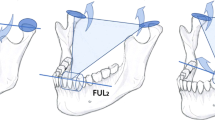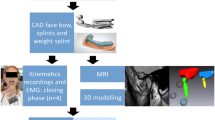Abstract
Objectives
In unilateral biting or chewing, the working/balancing-side ratio (W/B-ratio) of masseter activities is inversely proportional to the jaw gape which was interpreted as a neuromuscular strategy to protect occlusion. This suggests that jaw separation is afferently perceived, raising the question how this perception might work. In related studies, isometric biting was exerted on rubber pieces that slightly yielded similar to compressed food in chewing. We hypothesized that minor jaw movements associated with this yielding are necessary to elicit a jaw gape-related control of relative activation in isometric biting.
Materials and methods
Surface electromyograms of masseter muscles were recorded bilaterally in 20 males during (a) unilateral chewing, (b) isometric biting on rubber pieces inducing jaw gapes of 5, 3, 2, 1, and 0.5 mm, and (c) isometric biting with teeth embedded in rigid splints causing gapes of 5 and 1 mm.
Results
With rubber, the masseter W/B-ratio increased from 100 % (5 mm) to 166 % (1 mm) (p = 0.0003) whereas with the splint it increased just slightly to 112 % (p = 0.005). With 1 mm gape, W/B-ratios in splint biting were significantly smaller than in rubber biting or in chewing (p = 0.01).
Conclusions
We conclude that minor jaw motion preceding peak force in unilateral biting is necessary to create afferent sensory information that could elicit jaw gape-related activation of masseter muscles.
Clinical relevance
Demonstrating a condition under which jaw gape-related activation can lose its occlusion protecting effect, these findings might contribute to disclose the causes of craniomandibular disorders.




Similar content being viewed by others
References
Koolstra JH, van Eijden TMGJ, Weijs WA, Naeije M (1988) Three-dimensional mathematical model of the human masticatory system predicting maximum possible bite forces. J Biomech 21:563–576
Throckmorton GS, Groshan GJ, Boyd SB (1990) Muscle activity patterns and control of temporomandibular joint loads. J Prosthet Dent 63:685–695
Trainor PG, McLachlan KR, McCall WD (1995) Modelling of forces in the human masticatory system with optimization of the angulations of the joint loads. J Biomech 28:829–843
Iwasaki LR, Petsche PE, McCall WD, Marx D, Nickel JC (2003) Neuromuscular objectives of the human masticatory apparatus during static biting. Arch Oral Biol 48:767–777
Schindler HJ, Rues S, Türp JC, Schweitzerhof K, Lenz J (2007) Jaw clenching: muscle and joint forces, optimization strategies. J Dent Res 86:843–847
Hannam AG (2010) Current computational modelling trends in craniomandibular biomechanics and their clinical implications. J Oral Rehabil 38:217–234
Van Eijden TMGJ, Brugman P, Weijs WA, Oosting J (1990) Coactivation of jaw muscles: recruitment order and level as a function of bite force direction and magnitude. J Biomech 23:475–485
Schindler HJ, Lenz J, Türp JC, Schweizerhof K, Rues S (2009) Small unilateral gap variations: equilibrium changes co-contraction and joint forces. J Oral Rehabil 36:710–718
Pröschel PA, Jamal T, Morneburg TR (2008) Motor control of jaw muscles in chewing and in isometric biting with graded narrowing of jaw gape. J Oral Rehabil 35:722–728
Proeschel P, Morneburg T (2010) Indications for jaw gape related control of relative muscle activation in sequent chewing strokes. J Oral Rehabil 37:178–184
Schubert D, Pröschel P, Schwarz C, Wichmann M, Morneburg T (2012) Neuromuscular control of balancing side contacts in unilateral biting and chewing. Clin Oral Investig 16:421–428
Korioth TW, Hannam AG (1994) Deformation of the human mandible during simulated tooth clenching. J Dent Res 73:56–66
Kuboki T, Azuma Y, Orsini MG, Takenami Y, Yamashita A (1996) Effects of sustained unilateral molar clenching on the temporomandibular joint space. Oral Surg Oral Med Oral Pathol Oral Radiol Endod 82:616–624
Baba K, Yugami K, Yaka T, Ai M (2001) Impact of balancing-side tooth contact on clenching induced mandibular displacements in humans. J Oral Rehabil 28:721–727
Palla S, Gallo LM, Gossi D (2003) Dynamic stereometry of the temporomandibular joint. Orthod Craniofac Res 6:37–47
Okano N, Baba K, Ohyama T (2005) The influence of altered occlusal guidance on condylar displacement during submaximal clenching. J Oral Rehabil 32:714–719
Jacobs R, van Steenberghe D (1994) Role of periodontal ligament receptors in the tactile function of teeth: a review. J Periodont Res 29:153–167
Laine P, Siirilä HS (1977) The effect of muscle function in discriminating thickness differences interocclusally and the duration of the perceptive memory. Acta Odontol Scand 35:147–153
Riis D, Giddon DB (1970) Interdental discrimination of small thickness differences. J Prosthet Dent 24:324–334
Clark G, Jacobson R, Beemsterboer PL (1984) Interdental thickness discrimination in myofascial pain dysfunction subjects. J Oral Rehabil 11:381–386
Morimoto T, Hamada T, Kawamura Y (1983) Alteration in directional specificity of interdental dimension discrimination with the degree of mouth opening. J Oral Rehabil 10:335–342
Morimoto T, Ozaki M, Yoshimura Y, Kawamura Y (1979) Effects of the interpolated vibratory stimulation on the interdental dimension discrimination in normal and joint defect subjects. J Dent Res 58:560–567
Kogawa EM, Calderon PDS, Lauris JRP, Pegoraro LF, Conti PCR (2010) Evaluation of minimum interdental threshold ability in dentate female temporomandibular disorder patients. J Oral Rehabil 37:322–328
Williams WN, Lapointe LL, Thornby JI (1974) Interdental thickness discrimination by normal subjects. J Dent Res 53:1404–1407
Goodwin GM, McCloskey DI, Matthews PBC (1972) The contribution of muscle afferents to kinaesthesia shown by vibration induced illusions of movement and by effects of paralysing joint afferents. Brain 95:705–748
Rymer WZ, D’Almeida A (1980) Joint position sense: the effects of muscle contraction. Brain 103:1–22
Proske U, Gandevia SC (2009) The kinaesthetic senses. J Physiol 587:4139–4146
Taylor JL, McCloskey DI (1990) Ability to detect angular displacements of the fingers made at an imperceptible slow speed. Brain 113:157–166
Clark FJ, Burgess RC, Chapin JW, Lipscomb WT (1985) Role of intramuscular receptors in the awareness of limb position. J Neurophysiol 54:1529–1540
Sessle BJ (2006) Mechanisms of oral somatosensory and motor functions and their clinical correlates. J Oral Rehabil 33:243–261
Goodwin GM, Luschei ES (1975) Discharge of spindle afferents from jaw-closing muscles during chewing in alert monkeys. J Neurophysiol 38:560–571
Broekhuijsen ML, van Willigen JD (1983) Factors influencing jaw position sense in man. Arch Oral Biol 28:387–391
Larson CR, Finocchio DV, Smith A, Luschei ES (1983) Jaw muscle afferent firing during an isotonic jaw-positioning task in the monkey. J Neurophysiol 50:61–73
Lund JP (1991) Mastication and its control by the brain stem. Crit Rev Oral Biol Med 1:33–64
Zakir HM, Kitagawa J, Yamada Y, Kurose M, Mostafeezur RM, Yamamura K (2010) Modulation of spindle discharge from jaw-closing muscles during chewing foods of different hardness in awake rabbits. Brain Res Bul 83:380–386
Larson CR, Smith A, Luschei ES (1981) Discharge characteristics and stretch sensitivity of jaw muscle afferents in the monkey during controlled isometric bites. J Neurophysiol 46:130–142
Hulliger M, Nordh E, Vallbo AB (1982) The absence of position sense in spindle afferent units from human finger muscles during accurate position holding. J Physiol 322:167–179
Proske U (2005) What is the role of muscle receptors in proprioception? Muscle Nerve 31:780–78
Matthews PBC (1972) The mammalian muscle receptors and their central actions. Edward Arnold, London, UK
McCloskey DI (1973) Differences between the senses of movement and position shown by the effects of loading and vibration of muscles in man. Brain Res 63:119–131
Johnsen SE, Trulsson M (2005) Encoding of amplitude and rate of tooth loads by human periodontal afferents from premolar and molar teeth. J Neurophysiol 93:1889–1897
Trulsson M (2006) Sensory motor function of human periodontal mechanoreceptors. J Oral Rehabil 33:262–273
Pantanowitz L, Nalogh K (2003) Significance of the juxtaoral organ (of Chievitz). Head Neck 127:400–405
Chambers MR, Andres KH, von Duering M, Iggo A (1972) The structure and function of the slowly adapting type II mechanoreceptor in hairy skin. Q J Exp Physiol 57:417–445
Edin BB (1992) Quantitative analysis of static strain sensitivity in human mechanoreceptors from hairy skin. J Neurophysiol 67:1105–1113
Johansson RS, Trulsson M, Olsson KA, Abbs JH (1988) Mechanoreceptive afferent activity in the infraorbital nerve in man during speech and chewing movements. Exp Brain Res 72:209–214
Matthews PBC (1988) Proprioceptors and their contributions to somatosensory mapping: complex messages require complex processing. Can J Physiol Pharm 66:430–438
Flanagan JR, Bowman MC, Johansson RS (2006) Control strategies in object manipulation tasks. Curr Opin Neurobiol 16:650–659
Langenbach GEJ, Hannam AG (1999) The role of passive muscle tensions in a three-dimensional dynamic model of the human jaw. Arch Oral Biol:557–573
Hylander WL, Johnson KR, Crompton AW (1992) Muscle force recruitment and biological modeling: an analysis of masseter muscle function during mastication in macaca fascicularis. Am J Phys Anthropol 88:365–387
Hermens HJ, Freriks B, Disselhorst-Klug C, Rau G (2000) Development of recommendations for SEMG sensors and sensor placement procedures. J Electromyogr Kinesiol 10:361–374
Türker KS (1993) Electromyography: some methodological problems and issues. Phys Ther 73:698–710
Merletti R (1999) Standards for reporting EMG data. J Electromyogr Kinesiol 9:III-IV
Farella M, Palumbo A, Milani S, Avecone S, Gallo ML, Michelotti A (2009) Synergistic coactivation and substitution pattern of the human masseter and temporalis muscles during sustained static contractions. Clin Neurophysiol 120:190–197
Castroflorio T, Falla D, Wang K, Svensson P, Farina D (2011) Effect of experimental jaw-muscle pain on the spatial distribution of surface EMG activity of the human masseter muscle during tooth clenching. J Oral Rehabil 39:81–92
Disselhorst-Klug C, Schmitz-Rode T, Rau G (2009) Surface electromyography and muscle force: limits in sEMG–force relationship and new approaches for applications. Clin Biomech 24:225–235
Meinecke L (2006) Quantifizierung des Crosstalk-Anteils in Oberflächen-Elektromyogrammen. Dissertation, RWTH Aachen, Helmholtz-Institut für Biomedizinische Technik, Aachen
De Luca CJ, Merletti R (1988) Surface myoelectric signal cross-talk among muscles of the leg. Electroencephalogr Clin Neurophysiol 69:568–575
Butler SL, Miles TS, Thompson PD, Nordstrom MA (2001) Task-dependent control of human masseter muscles from ipsilateral and contralateral motor cortex. Exp Brain Res 137:65–70
Schieppati M, Di Francesco G, Nardone A (1989) Patterns of activity of perioral facial muscles during mastication in man. Exp Brain Res 77:103–112
Hanawa S, Tsuboi A, Watanabe M, Sasaki K (2008) EMG study for perioral facial muscles function during mastication. J Oral Rehabil 35:159–170
Tucker KJ, Türker KS (2005) A new method to estimate signal cancellation in the human maximal M-wave. J Neurosci Methods 149:31–41
Simonsen EB, Dyhre-Poulsen P (1999) Amplitude of the human soleus H reflex during walking and running. J Physiol 515:929–939
Gerilovsky L, Tsvetinov P, Trenkova G (1989) Peripheral effects on the amplitude of monopolar and bipolar H-reflex potentials from the soleus muscle. Exp Brain Res 76:173–181
Castroflorio T, Bracco P, Farina D (2008) Surface electromyography in the assessment of jaw elevator muscles. J Oral Rehabil 35:638–645
Acknowledgment
We gratefully acknowledge support of this work by Wilhelm–Sander Foundation Grant No. 20030091.
Conflict of interest
The authors declare that they have no conflict of interest.
Author information
Authors and Affiliations
Corresponding author
Rights and permissions
About this article
Cite this article
Morneburg, T.R., Döhla, S., Wichmann, M. et al. Afferent sensory mechanisms involved in jaw gape-related muscle activation in unilateral biting. Clin Oral Invest 18, 883–890 (2014). https://doi.org/10.1007/s00784-013-1024-1
Received:
Accepted:
Published:
Issue Date:
DOI: https://doi.org/10.1007/s00784-013-1024-1




